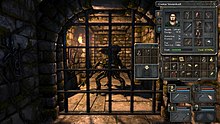Dungeon crawl
This article needs additional citations for verification. (January 2008) |

A dungeon crawl is a type of scenario in fantasy role-playing games in which heroes navigate a labyrinth environment (a "dungeon"), battling various monsters, avoiding traps, solving puzzles, and looting any treasure they may find.[1] Video games which predominantly feature dungeon crawl elements are considered to be a genre.[1]
The first computer-based dungeon crawl was pedit5, developed in 1975 by Rusty Rutherford on the PLATO interactive education system based in Urbana, Illinois. Although this game was quickly deleted from the system, several more like it appeared, including dnd and Moria.[1]
First-person party-based dungeon crawlers[]

This subgenre consists of RPGs where the player leads a party of adventurers in first-person perspective, typically in a grid-based environment. Examples include the aforementioned Wizardry, Might and Magic and Bard's Tale series; as well as the Etrian Odyssey and Elminage series. Games of this type are also known as "blobbers", since the player moves the entire party around the playing field as a single unit, or "blob".[3][4]
Many "blobbers" are turn-based, such as the play-by-mail game Heroic Fantasy, but some games such as Dungeon Master, Legend of Grimrock and Eye of the Beholder series are played in real-time. Early games in this genre lack an automap feature, forcing players to draw their own maps in order to keep track of their progress. Spatial puzzles are common, and players may have to, for instance, move a stone in one part of the level in order to open a gate in another part of the level.[citation needed]
Video games[]

Due to their potential for simplicity and the limited expectations most players have for plot and logical consistency in dungeon crawls, they are fairly popular in role-playing video games.[citation needed] The roguelike genre is a common and typical example, with endless procedurally generated dungeon terrain and randomly placed monsters and treasures scattered throughout.
Computer games and series from the 1980s, such as The Bard's Tale, Cosmic Soldier, Dungeon Master, Gauntlet, Madō Monogatari, Megami Tensei, Might and Magic, Phantasy Star, Ultima, and Wizardry, helped set the genre's standards, while the primitive graphics were actually conducive to this style, due to the need for repetitive tiles or similar-looking graphics to create effective mazes.
Some dungeon crawlers from this era also employed action role-playing game combat, such as Dragon Slayer,[5] and The Tower of Druaga.[6]
Variations on the dungeon crawl trope can be found in other genres. In the early 2010s there was a modest resurgence in their popularity, particularly in Japan, largely due to the success of the Etrian Odyssey series by Atlus.[7]
Instance dungeon[]
In massively multiplayer online games, an instance is a special area, typically a dungeon, that generates a new copy of the location for each group, or for certain number of players, that enters the area.[8] Instancing, the general term for the use of this technique,[8] addresses several problems encountered by players in the shared spaces of virtual worlds, but also sacrifices the social element of shared spaces, and the feeling of realistic immersion in that virtual world. They also tend to be a lot smaller and more linear.
See also[]
References[]
- ^ Jump up to: a b c Brewer, Nathan. "Going Rogue: A Brief History of the Computerized Dungeon Crawl". IEEE-USA InSight. Archived from the original on 10 January 2020. Retrieved 10 January 2020.
- ^ Edge Staff (2012-04-12). "Legend Of Grimrock review". Edge. Archived from the original on July 10, 2012. Retrieved 2012-05-09.
- ^ Cobbett, Richard (December 5, 2016). "The RPGs of 2017". Rock Paper Shotgun. Retrieved 2017-05-22.
- ^ Pepe, Felipe (June 25, 2015). "CRPG History Abridged - 21 RPGs that brought something new to the table". Gamasutra. UBM. Retrieved 2017-05-22.
- ^ Kalata, Kurt. "Dragon Slayer". Retrieved 10 January 2020.
- ^ Parish, Jeremy (30 July 2012). "What Happened to the Action RPG?". 1UP.com. Archived from the original on 3 October 2018. Retrieved 10 January 2020.
- ^ Parish, Jeremy (2011-09-15). "TGS: Beyond the Labyrinth is Beautiful But Puts the "Crawl" in "Dungeon-Crawler." (Nintendo 3DS) - Konami's new 3DS RPG is probably too specific to Japanese tastes to come to the U.S." 1UP.com. Archived from the original on 28 November 2011. Retrieved 16 September 2011.
- ^ Jump up to: a b Simon Carless (2004). Gaming hacks. O'Reilly Media. p. 112. ISBN 978-0-596-00714-0.
A term used to describe a private portion of a gameworld created just for an individual or group of players.
- Dungeon crawler video games
- Role-playing game terminology
- Video game genres
- Video game terminology